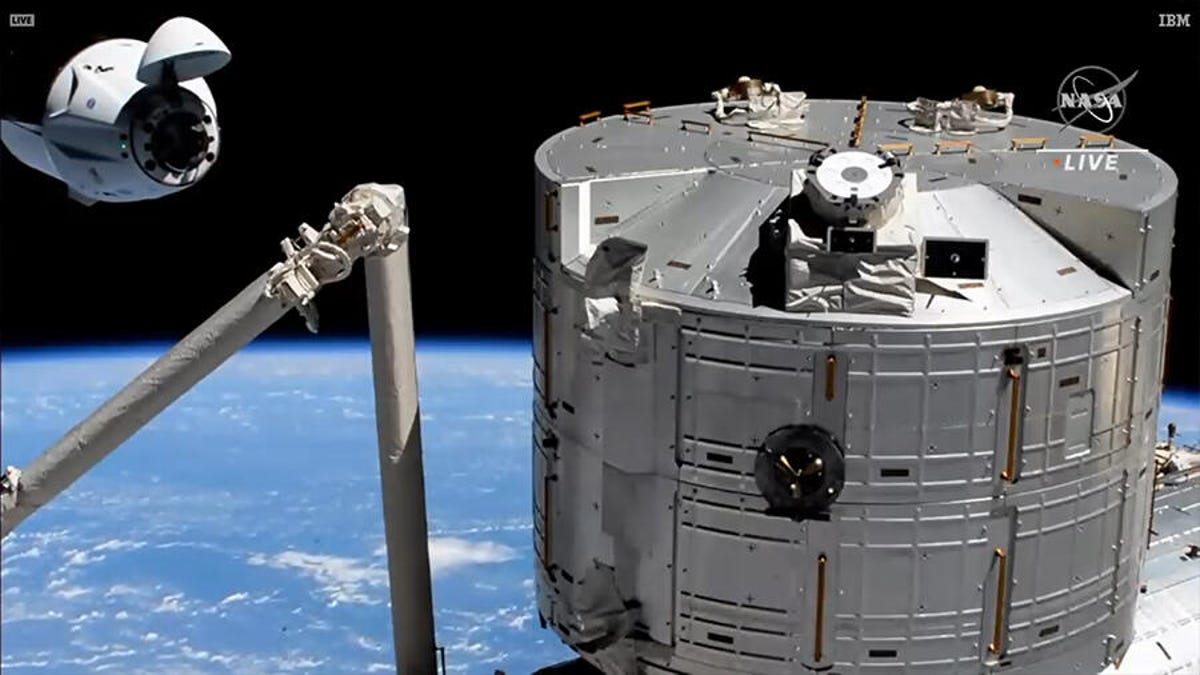SpaceX, NASA Crew-2 astronauts dock with space station, climb aboard
"Hugs abound," says NASA, as the four astronauts join those already aboard. It's the third time SpaceX has ferried astronauts to the International Space Station.

Preparing to dock.
After heading skyward atop a SpaceX Falcon 9 rocket Friday, the four astronauts of NASA's Crew-2 mission safely climbed -- make that floated -- aboard the International Space Station early Saturday morning. Their Crew Dragon capsule, the Endeavour, docked with the ISS just after 2 a.m. PT, and the astronauts made their way into their new home about two hours later.
"Their arrival means there are now 11 humans aboard our orbiting laboratory," NASA tweeted, "a number not seen since the space shuttle era. Hugs abound." The space agency included footage of the Crew-2 astronauts having a bit of zero-gravity fun as they drifted from the capsule into the ISS.
"Endeavour arriving!" Welcome to the @Space_Station, Crew-2!
— NASA (@NASA) April 24, 2021
Their arrival means there are now 11 humans aboard our orbiting laboratory, a number not seen since the space shuttle era. Hugs abound. pic.twitter.com/uSwW3JFl6K
The Endeavour astronauts -- NASA's Megan McArthur and Shane Kimbrough, the European Space Agency's Thomas Pesquet and the Japan Aerospace Exploration Agency's Akihiko Hoshide -- join the seven Expedition 65 crew members already aboard the ISS. The four Crew-1 astronauts who arrived last November are scheduled to undock their Crew Dragon Resilience capsule on Wednesday to head back to Earth. Saturday's new arrivals at the ISS are set for a six-month science mission aboard the space station.
The Crew missions are part of the Commercial Crew Program, in which NASA is working with private companies, including SpaceX, to achieve the space agency's stated goal of "safe, reliable and cost-effective access to and from the International Space Station and low-Earth orbit." The program also ties in with NASA's Artemis and Moon to Mars plans. Artemis calls for putting the first woman and next man on the moon by 2024 -- and setting up sustainable exploration by the end of the decade. Knowledge gained from Artemis will be put to use in getting ready to send astronauts to the red planet.
Read more: Welcome to Mars (special report)
Last week, NASA announced that it had selected SpaceX to provide the human landing system for the Artemis program.
Crew-2 marks the third time Elon Musk's SpaceX has ferried astronauts to the ISS, following November's Crew-1 mission and the historic Demo-2 test flight last May -- the first US spaceflight to make the journey in nine years. Endeavour was used for the Demo-2 trip, and it's not the only SpaceX gear that's notched up another flight this time around: The Falcon 9 rocket reused a booster from Crew-1.
Until recently, NASA was purchasing flights to the ISS on the Russian Soyuz spacecraft. Flying SpaceX, NASA will save around $25 million per seat. The space agency has also contracted Boeing to deliver astronauts to the ISS, but the company's crewed spacecraft, Starliner, ran into technical issues during its first uncrewed demonstration launch. Boeing is preparing to try again with the Starliner, in August or September, the company said this week.
CNET's Amanda Kooser and Jackson Ryan contributed to this report.

